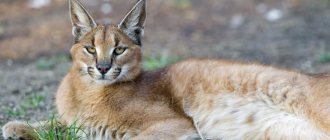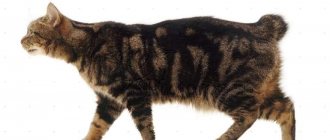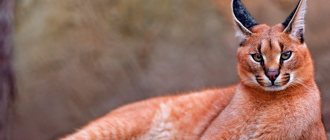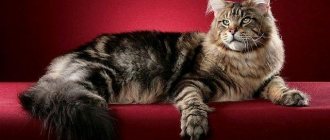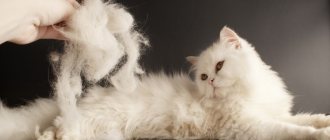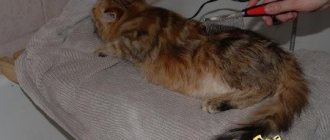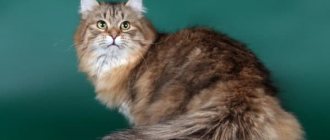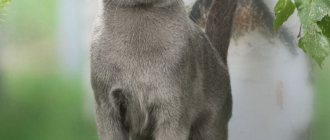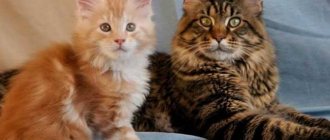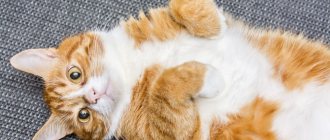Interesting facts from the life of animals
The lynx is a typical cat, about the size of an adult large dog with its tail cut off. You can meet her in the taiga or forest, but she is so careful that very few succeed.
Such a lynx is unlikely to be suitable for domestic conditions, although today there are cases where the taming of a lynx has become a completely successful event.
Domestic lynx
differs from its wild relative, as it belongs to an artificially bred breed, which was developed by crossing small wild breeds of lynx with ordinary cats of a suitable color. It is worth noting that they are still working on breeding a real domestic lynx.
Domestic lynxes have the appearance of a real Canada lynx, namely, a strong and flexible body, long legs and pronounced muscles, thick and short hair, a wide nose and almond-shaped eyes. As for the size of the domestic lynx, it is about half the size of the wild lynx that can be seen in the zoo or on TV.
Many cat lovers wonder what breeds of lynx exist that can be kept at home. Particular attention is paid to such a domestic species as the caracal.
Caracal - domestic lynx
, which can become an absolutely harmless pet, but on the condition that it will grow up in captivity from childhood under the careful care of its owners. Caracal requires special attention and special conditions for keeping.
It will be good if a spacious enclosure is built for the pet animal, where it can walk freely and sharpen its claws. To do this, you will need to choose a place for an enclosure with a growing tree or, after building it, plant a young tree.
Or build a special structure from boards.
You need to start training a caracal from childhood; caracal kittens are the best to train. If you decide to adopt an adult animal, then think a hundred times before such an important step, since an adult caracal is unlikely to become so obedient.
How to keep a lynx at home and what to feed
Lynx at home
– this is a very serious step that should be taken with full responsibility and well prepared. First of all, you need to understand that keeping a lynx at home is quite a troublesome task and requires time and money from the owners.
Not to mention that it is not difficult to buy a domestic lynx today, but quite expensive. You can feed a lynx the same way as a regular domestic cat, but you won’t be able to get by with dry food alone.
Lynx requires regular consumption of meat and fish, and the diet must also contain bones, which will provide stress on the jaw muscles.
It is worth noting that a lynx, like a cat, swallows fur when licking and often choke on it. Therefore, owners should regularly care for the cat's fur and systematically comb it.
When asked if lynx is dangerous
, it is impossible to answer unambiguously.
The wild lynx is a predator and can be dangerous to keep at home.
Expert opinion Smirnov Alexander Stanislavovich Wilderness survival instructor. More than 15 years of teaching experience
An artificially bred domestic lynx can become a very interesting, trainable and friendly pet. But still, it is not recommended to have a lynx at home where there are small children.
Although this type of cat has predatory instincts hidden deeply and is a completely harmless animal in appearance, there is no guarantee that something irreparable could happen if these instincts are awakened.
Test drive Lada 4x4 “Lynx”. Don't tell foreigners about her
The company with the complex name “Production of Bronto Special Vehicles” died quietly in 2013. More precisely, “Bronto” was “merged” with another “daughter” of VAZ - . Because by that time, the losses of the Bronto PSA itself made its autonomous existence almost impossible, and the VAZ management had neither the opportunity nor the need to sponsor the small-scale production of armored cars and SUVs.
But “Bronto” began as a completely promising project...
Since 1993, Bronto, acting as a court atelier of AvtoVAZ, has been building custom-made armored vehicles based on the Niva. A couple of years later, they were supplemented by an extended version of the Niva called “Fora” and an all-terrain vehicle “Marsh” - essentially the same Niva, mounted on a UAZ frame and ultra-low pressure wheels.
It didn’t become a big business, but “Bronto” made money at the very least for experiments with various modifications of the Niva. And it was quite prestigious for VAZ to have a satellite company that regularly supplied spectacular and unusual cars to various exhibitions - Landole, Desant, electric Brontocar...
“Bronto” was crippled by two circumstances that merged into one. The 2008 crisis made the flow of buyers vanishingly small, not justifying the maintenance of a separate production site. And most importantly: in 2009, the new director of VAZ, Igor Komarov, proclaimed a course towards ruthless optimization, the need for which was dictated not so much by the financial crisis (his VAZ passed thanks to targeted state support), but by the interests of new shareholders in the person of the Renault-Nissan alliance.
Since 2008, Bronto has shown a stable loss (in 2008 - 14.281 million rubles, in 2009 - 6.046 million rubles). And in 2011, the slow transfer of Bronto’s production assets to VIS-Auto began. It was assumed that from 2014 the Bronto brand would completely disappear from the VAZ nomenclature, but this has not happened yet - consumers still have a strong associative connection between this brand and extreme SUVs made on the basis of the Lada 4x4.
The last director of PSA Bronto, Anatoly Okhrimets, is an incredibly passionate person. It seems that debit-credit is the last thing he thinks about. He is simply not interested in this, he soars in other heights, perhaps not mountainous, but quite romantic. Even when “Bronto” was firmly on its feet, Okhrimets gave out variants of the Niva, one bolder than the other - a beach buggy, a light reconnaissance vehicle...
After leaving Bronto, Anatoly Viktorovich organized, with the aim of producing for the military an attack and reconnaissance (“URA”) vehicle based on Lada 4x4 units, essentially the same rear-engine buggy.
Photo by Vitaly Kuzmin
Here is Okhrimets posing at one of the exhibitions in the company of a potential customer - Rosoboronexport representative Oleg Sevastyanov.
Buggy “URA” and Anatoly Okhrimets (left). Photo ARMS-TASS
It seems that a contract was even signed for the purchase of a trial batch of URA vehicles (4 units), but we have no information about its implementation.
At the same time, Anatoly Viktorovich is trying to put into production a new version of the March - a Lada 4x4 on ultra-low pressure wheels, but already frameless, which means lighter than the cars from Bronto.
The frameless heir to "Marsh". Photo Avtosreda.ru
We are talking about Okhrimets because without him, the heroine of the further story would hardly have been born - Lada 4x4 21214-0000070-20, called “Lynx”. The concept of a slightly lifted old Niva is his concept. This is the only PSA Bronto product produced in any commercial quantities (200-300 cars per year).
“Lynx” formally appeared in February 2009, but, of course, Togliatti learned how to lift and retrofit the Niva long before. They have been doing this for almost 40 years, and not only in Tolyatti; home-made workers have accumulated enormous experience. You can easily make an all-terrain vehicle of any degree of extremeness from a Lada 4x4, the only question is the price. But the more extreme an SUV is, the further it will stray from the base car's normal on-road capabilities. Try to drive the same “March” on asphalt, I guarantee a very unusual sensation... The idea of the “Lynx” is to make tuning of such a level as to maintain decent behavior of the car on public roads. Stop at the point beyond which the sheer off-roading and pointlessness of operating a car in the city begin.
These are the changes made to the design of the Lada 4x4. The standard shock absorbers and springs were replaced with ShNivovskie ones (2123), and due to the spacers, the body was “lifted” by about 40 mm. The range of articulation of the front suspension has increased by 25 mm, and the rear by 50 mm. In the official description there is a mention of the use of UAZ shock absorbers in the rear suspension, but the chief designer of VIS-Auto, Oleg Shirokov, said that now they only use Chevrolet Niva ones.
The raised body allowed the installation of much more impressive wheels - pronounced Cordiant Off Road 235/75R15 off-road tires on original alloy wheels. The wheel offset has increased, so the wheel arches were equipped with rubber tape extensions that protect the body from sandblasting.
The power unit remained unchanged; it is still a 1.7-liter gasoline engine with 83 hp. paired with a five-speed manual transmission. And to increase traction capabilities, they increased the gear ratio of the main pairs, from 3.9 to 4.1, simultaneously replacing the free cross-axle differentials with self-locking ones, from the Tolyatti company VAL-racing. These are ordinary screw “self-blocks” with a preload of 4.5 kg and a blocking coefficient of 0.5 (50%). That is, they are quite gentle devices that do not seriously affect handling. Here's how they are placed:
Reinforce the rear axle beam with several stiffeners:
With all these alterations, the Lynx became only slightly heavier, and the track increased by 38 mm, to 1478/1468 mm, respectively.
The list of additional equipment that the manufacturer can offer is quite wide, from air conditioning, a sunroof, a roof rack with an integrated “chandelier” - to replacing the cardan joints on the shafts of both axles with CV joints.
By default, the Lynx has universal joints
In general, with such a small production volume, VIS-Auto takes advantage of the possibilities of individualization. There is an original body coloring, and total sound insulation... But what they don’t do (and, it seems, in vain) is changing the transfer case mounting - introducing a third support or even installing it on a separate subframe to ensure full alignment with the gearbox.
"Lynx" officially exists in four modifications. The one made on the basis of the three-door VAZ-21214 is called “Lynx-1”.
“Lynx-2” is the same thing, but only on the basis of a five-door car (VAZ-2131), produced at the VAZ OPP.
“Lynx-3” is already made on the basis of a five-door pickup truck, with a superstructure in the rear and a raised roof.
And finally, the “fourth Lynx” is the same five-door station wagon, but with a modified roof.
Cars with letters 3 and 4 are exclusive, only a few of them are made, the demand for such bodies is enormous.
But the subject of our interest and passion is the standard Lynx, a basic three-door car. Among other things, this example is equipped with a massive roof rack with four additional Hella headlights.
The design of the expeditionary trunk is strong, clearly exceeding the load-bearing capacity of the drainage gutters to which it is attached. VAZ does not recommend carrying more than 50 kg on the roof; for the same trunk they ask for at least a couple of hundred kg, not counting the dead weight of the structure. This is, in some way, a provocation. However, I have no doubt that the trunk will easily handle a couple of spare parts. Would they withstand the attachments to the gutters...
The interior of the Lada 4x4, although updated from time to time in design, is not much different in terms of convenience from what it was 40 years ago. The steering wheel is not adjustable, the gear shift lever is moved too far forward, the climate control is controlled by mechanical “sliders”... The three-speed heater fan howls already at its first speed.
The plastic parts in the cabin “come in waves,” striking with the clumsiness with which they are fitted into their rightful places. Uncovered screw heads stick out everywhere, some of which were clearly screwed in with excessive zeal.
Just don’t laugh: VAZ still uses a roughly cut piece of hardboard as a backing for the rear seat cushion!
Ancient fuse boxes sit alongside a colorful riot of exposed wires.
The ignition switch is located in the most inconvenient place, on the left side of the steering column, a la Porsche. What the Italians came up with in 1965 looks like a slap in the face of the consumer in 2015.
And there are no particular difficulties in moving the lock to the right, but money, money... On the old Niva, VAZ drivers save to the point of misery; it is believed that no serious investment program will pay off with such a volume of output. Even if you don’t take into account that the Lada 4x4 will be produced before the launch of Niva-3, which is at least another four to five years. After all, the technical specifications for the Niva-3 project have not yet been finally approved.
On the floor of the Lynx, instead of a pile carpet, there is something rubber-like, covered with rubber mats. This coating does not add comfort, but it is easy to clean, which is probably more important for an SUV.
Door decorative overlays are fixed with self-tapping screws, thank God, camouflaged with special plugs.
This is more reliable than fastening with modern self-locking “pistons”. When moving, the trim is silent, but something rattles in the rear door...
The front seats are surprisingly comfortable.
An SUV, which has become a fetish among journalists, doesn’t really need lateral support. And here it is just such that it does not interfere with landing, but also does not allow the entire driver’s body to slide to the sides in harmless turns. There are also no problems with reclining the seats for access back - the primitive mechanism works clearly, opening a sufficient opening.
It’s a bit high, so much so that it’s still not very comfortable to sit in the back seat. Only if you were not a rear passenger in Oka or Tavria. Or, God forgive me, Zaporozhets: this is where flexibility, coupled with love for the homeland, was needed!
The Lynx vibrates at idle more than modern standards of decency allow. The trembling on the levers is understandable and explainable, they stick straight out of the gearbox and transfer case housings, there is no vibration decoupling. What’s worse is that the pulsations from the operation of the crank mechanism are persistently transmitted to the steering wheel. An unsightly, uncomfortable steering wheel made of poor plastic. Also standing at an awkward angle - an eternal reminder of the ergonomic failures of Peter Prusov’s team.
An even bigger miscalculation is the transfer case, or more precisely, the way it is attached. Moved away from the gearbox, it is misaligned with it and the short intermediate shaft cannot but cause increased vibrations. It was really bad in the first years of Niva production, when single-row bearings were installed in the transfer case at the outputs of the front and rear cardan shafts, and the intermediate shaft was equipped with a cardan joint. Now the intermediate shaft operates through a constant velocity joint, and double-row bearings have been introduced into the transfer case cover, which has greatly reduced the vibration load and noise of the machine. But still, the two-point mounting of the transfer case and its natural misalignment with the gearbox have not been eliminated and are manifested by obsessive noise and vibration discomfort. A radical option is to fix the transfer case on a simple subframe, giving it a third support, but VAZ itself does not approve of such a modification. Therefore, the Lynx, being an “official” production model, and not a product of garage tuning, is doomed to exist as a bass shaker.
But all these considerations cease to have any significance about three minutes after the start of off-road driving. What vibrations, what inconvenience of landing, what are you talking about? We are preparing for a descent into hell here, don’t distract us.
Developing a route for the Lynx is not about choosing a road, but about laying out a direction between obstacles. And then - a slight sensation of flying over what for ordinary cars turns out to be bent levers and torn out ball joints. Well, yes, it wobbles, but not critically, it does not affect orientation in space. A toss, a brief moment of weightlessness, a delicate landing. A slight slip that does not change the trajectory. A fan of snow mush, another jump, now higher and further away. And - throttle to the floor on the third, until it got dark, until this snow-covered field, this copse with earthen hollows, this smooth surface of the pond with frozen blades of reeds were gone around.
The 83-horsepower engine with a ridiculous torque (129 N.m.) is vigorous and cheerful: howls, twitches, and is slightly blunt when actively throttling. But the car itself is not heavy, only 1210 kg, according to the official website. In reality, of course, a little more, about 40 kilograms (self-blocks, suspension, roof rack), but this is not fundamental. The Lynx’s traction is not so much the engine itself, but rather the new main pairs and a lower row in the transfer case. Plus larger diameter wheels. If we sum up all the gear ratios, we get an almost threefold increase in comparison with the base car in the “top” row.
As a matter of fact, you only want to turn to the lower row in critical situations, but there is enough torque even for very steep climbs. The Lynx will probably easily cope with a heavy trailer. The wheels also have enough grip, although snow and ice are not the natural elements of Cordiant Off Road, which are designed more for dirt and sand.
The geometry of the basic Niva, even without modifications, was very “off-road”; the wheels were placed almost at the corners of the short body, which gave minimal overhangs. Due to the elevation of the Lynx, the approach and departure angles have become even more interesting. If the car does not immediately hit the bumper against an obstacle, then most likely this obstacle will be overcome.
In front of this hill, the driver from VIS-Auto said sadly: no, it won’t come. And then he himself, after praying, moved in.
And I was even surprised: really? I was so surprised that I began to storm this climb again and again while I was running around with the camera. Liked)))
The nature of the operation of self-locking differentials strongly depends on the speed of “throttle”. With a sharp start, a rigid connection is formed instantly, which is accompanied by a characteristic sharp tapping and nervous twitching of the car. But with careful throttling, the blocking level increases extremely slowly. If the car is hung diagonally, then smoothly accelerating it will move it only after three to four seconds; it is better to accelerate quickly and confidently. And when starting on ice with a locked center differential, you will need to compensate for small trajectory yaws.
And yet, the inherent “Nivov” inconveniences do not go away. And after the level of the “hormone of off-road happiness” drops in the blood, these inconveniences come out in all their obviousness. The gas pedal travel is very small, it is inconvenient to change gears, and the transfer case control levers have no feedback at all: did you turn it on? didn't turn it on? The “center” lock does not turn on if the car is parked even at a slight angle, so this must be done (as any “jeeper” knows) not during “landing,” but much before.
It’s nice that the hydraulic booster did not in any way reduce the information content of the Niva’s steering. Although, what information content with a worm gearbox... Nevertheless, the car “steers” clearly, but the power steering makes a lot of noise in the extreme positions of the wheels. Clearly more than I should.
We drive out onto a normal asphalt road... No, we shouldn’t have done that. “Lynx” instantly, from the very first meters, began to lose its uncouth charm. Becoming simply uncouth. Trajectory yaw is monstrous; the short wheelbase, so blessed in mud, on a normal road forces the Lynx to only roughly adhere to the given course. Catching a car is an exhausting task, and as the speed increases, it turns into hard work. Fortunately, the Lynx doesn’t impress with its speed capabilities—it’s not its element. But even with a peaceful ride within the framework of the Lynx traffic rules, it’s still an experience. Seasoned with the only positive: there are almost no road potholes of any configuration for the Lynx. In principle, she doesn’t care whether she drives on the road or next to it. It’s even safer nearby; you won’t hit other cars.
The worst thing I did in this car was to brake to the floor from a speed of 90 km/h. How we didn’t kill ourselves, I can’t imagine. The lynx moved sharply to the left, and was caught only by a miracle. There is clearly something wrong with the uniformity of the brakes on the sides in this car...
It is clear that the UAZ Hunter is even more inconvenient - and this is the only domestic car that competes with the Lynx in cross-country ability. Compared to Hunter, the Lynx is at least comfortable and controllable. But against the backdrop of all the other achievements of the global automotive industry as of 2015...
This is some kind of cognitive dissonance. “Lynx” is beautiful, “Lynx” is magical beyond the borders of civilization, alone with muddy or frozen nature. And the “Lynx” causes bewilderment when surrounded by other cars; it is uncomfortable and even scary. It seems that space is collapsing, that it is becoming unacceptably small, that “Lynx” is suffocating.
By the way, you can get used to the slow flow of the city. But for long-distance voyages with the inevitable need for overtaking... The most difficult thing for the Lynx is high-speed overtaking. The car has too little strength and their specialization is completely different. People, they say, get used to everything. And apparently I just didn’t have enough time to...
Now a little about the patient - about the prospects for modernizing the Lada 4x4 and, as a result, the Lynx. The M3 project, in which the car was supposed to receive a motor from Priora and rack and pinion steering, was closed, it was expensive, they say. And it’s not really necessary - it’s time to make Niva-3. At the same time, they launched an adaptation for the Lada 4x4 diesel Fiat 1.3 16v MultiJet. Which is more difficult and more expensive.
For some reason, it seems to me that VAZ will return to the idea of installing a “front-wheel drive” engine and rack on the Lada 4x4. This would be a very logical step during a smooth transition to Niva-3, where this will undoubtedly be done. Then the Lynx, having received new units, will become a much more urban car without losing its off-road capabilities.
In the meantime, the Lynx remains a niche fan car: only 182 of them were made last year. Plus another 32 long-wheelbase Lynx-2s.
As of mid-February, “Lynx” in Moscow can be bought for 536,000 rubles. Or you can convert a standard Lada 4x4 into a “Lynx”, it will cost 80,000 rubles. (though without strengthening the rear axle). This is, by world standards, incredibly cheap.
I’ll say more: there are no SUVs for $8,000 with such spectacular cross-country ability in the world. At all. And I’m a little surprised that foreigners didn’t line up in front of the VIS-Auto office, clutching “cutlets” of bucks in their overworked farmer hands.
They probably just don’t know about Lynx.
So use it before you find out.
How much does a live domestic lynx cost in Russia?
There are many species of wild cat. Let's look at the prices for the main ones.
- Red lynx, or red – 50 thousand rubles.
- Canadian – 40 thousand rubles.
- Ordinary – 100 thousand rubles.
- Pyrenean, or Spanish - it is not possible to buy legally, as it is listed in position 1 of CITES.
Meanwhile, wild species are difficult to domesticate. Thanks to crossbreeding, breeds have been developed that are characterized by a gentle disposition and good tamability. Naturally, this could not but affect the price aspect.
- Steppe lynx, or caracal – 400 thousand rubles. Due to the noticeable external similarity, this animal was classified as a lynx species, but today it belongs to a separate genus. If raised correctly, these kittens turn into playful and friendly adult pets.
- Karaket – from 850 thousand to 1 million rubles. This species was the result of mixing a domestic cat with a caracal. This is a rather peaceful, friendly breed, sometimes very independent, but not at all aggressive. A hybrid belonging to the first generation is more valued, the cost of which often exceeds 1 million rubles. By the way, the caracat is more similar to the lynx.
- Domestic lynx - from 400 thousand to 1 million rubles. These representatives are a cross between a domestic cat and a Canadian lynx. In appearance it is similar to its wild ancestor, but from the domestic cat the lynx got its active character, tenderness and love for humans.
Keeping such pets does not require a huge amount of space, and there are no risks associated with living with a wild animal. For how many rubles you can purchase such representatives, we will consider further.
- Siberian cat – from 7 to 15 thousand rubles. This little beauty was the result of a love for wild cats that lived in the Trans-Urals and oriental breeds. The thick coat is due to the harsh climate. The tassels on the ears resemble wild relatives. A characteristic feature of this breed, in addition to its complacent disposition, is attachment to only one owner.
- Norwegian forest - from 12 to 70 thousand rubles. and more. Their large size and powerful stature should not frighten you, because these Norwegian cats have a kind and reserved disposition. By the way, they are ready to get along with noisy children and with other tribesmen, for example, with dogs.
- Pixie bob – from 30 to 100 thousand rubles. This breed is quite young and rare. These cats have a canine character, are very smart, and calm. They tolerate change negatively, and without human contact they can quickly become wild.
- Maine Coon - from 20 to 80 thousand rubles. One version says that such pets were the result of mating between an ordinary cat and a North American lynx.
- Kurilian bobtail – from 15 to 70 thousand rubles. These wonderful animals were bred on the Kuril Islands. This breed is perfect for someone who is looking for a fun and smart animal.
- American bobtail – from 35 to 90 thousand rubles. This species is very loving, characterized by ingenuity and intelligence. For example, these cats will have no difficulty leaving a closed cage.
Suggested Modifications
Currently, the Bronto Lynx is represented by several modifications; let’s look at the most popular ones. Niva Lynx 1 is a three-door station wagon, produced on the basis of Lada-21214, the length of which is 3740 mm. The five-door station wagon Niva Lynx 2 is produced on an extended Lada-21310 base, its length is 4240 mm.
The full name of these models is as follows:
- Lynx 1 - 212140-070-20 "Bronto-Lynx 1";
- Lynx 2 - 213100-070-41 “Bronto-Lynx 2”;
- Lynx 3 - 213100-770-41 "Bronto-Lynx 3".
The modifications are united by the identical structural design of the transmission, chassis and body described above. Comfortable driving of the Lynx is ensured by power steering and electric windows of the front doors. All models are equipped with a VAZ-21214 gasoline engine with distributed injection and electronic control. The working volume of this engine is 1690 cm3, rated power is 61 (83) kW (hp).
Tuning the Niva model
The curb weight of the three-door station wagon is 1210 kg. Niva Lynx 2 and the same long-wheelbase Lynx 3 have a slightly larger curb weight - 1350 kg. The different weights of the models naturally affect the difference in fuel consumption; on hard surfaces it can fluctuate in the range of 10.8-12 liters per 100 km. The fuel tank volume of Lynx 1 is 42 liters, Lynx 2 and 3 is 65 liters.
Hybrids
Caraquet
Caracats are a “kind” copy of caracals, the fruit of love between a representative of the latter and an Abyssinian cat. For a long time, breeders suffered defeats in their attempts to breed hybrid offspring capable of reproducing. Our compatriot from Krasnodar was able to succeed in this at the end of the 20th century. Thanks to her, this mixture of cat and steppe lynx combines wild beauty and gentle disposition.
The conformation of this new breed of lynx-like cat is identical to the caracal: the same body size, coat color, long hind legs and ear tufts. However, their character is much calmer and more peaceful than that of their wild ancestors. They love to play and get along well with their pet neighbors.
Caracats are easy to train to walk in a harness. They also need a well-equipped playground that satisfies their wild instincts.
Domestic lynx
Thanks to the efforts of breeders, crossing the Canadian lynx with domesticated cats with spotted skins gives us the opportunity to have a real lynx, only a domestic one. She has the same long hind legs, shortened tail, graceful curve of the spine, expressive almond-shaped eyes and “signature” ear tufts.
Individuals of the domestic lynx have thick gray-brown fur. Lynxes are incredibly beautiful, their fur has a gray-blue tint - it seems as if they have just rolled out in the snow.
Such a luxurious fur coat requires constant and thorough combing. Otherwise, the animal runs the risk of choking when licking
In general, caring for a domestic cat-lynx hybrid is identical to caring for a caracal or caraquet - a lot of movement, raw meat and constant attention
Caracal
The caracal is very similar in appearance to the lynx, but is slightly smaller in size. Just like the lynx, the caracal has dense, thick fur, lush dark tufts on the tips of the ears, and coarse bristly hair on the paws. It has a uniform red color with a whitish lower part. Melissas are rarely found - individuals with black coat color.
The caracal is a predatory animal, the original purpose of domestication was to help in hunting. Nowadays this exotic animal is purchased as a pet. Caracals are balanced and energetic. They are characterized by a love of games and affection, and curiosity.
The price varies from 400 to 500 thousand rubles.
You need to buy a pet at the age of 4-6 years and only in specialized nurseries.
If you buy at the market or on the Internet, there is a chance that you will purchase an animal that was caught in the wild and not accustomed to home conditions.
Such individuals are predatory and do not live at home.
Caracal
Grace and grace of the lynx
In nature, the lynx is a separate population of mammals, which in appearance is most similar to the cat population itself. Its dimensions do not exceed those of a large dog, which it slightly resembles with a short body and long legs. Lynxes are great at climbing rocks and trees. Its elongated hind legs, overgrown with hair in winter, help the animal to grip well on loose snow. A rather short tail does not prevent the lynx from moving through trees and mountains in the forest.
Lynxes live in the forests of central Russia, some European countries, the USA, Canada, Central Asia, as well as in the Scandinavian countries. The body length can reach up to 1.30 m, the height at the withers can be up to 0.7 m, and the weight varies from 5 to 30 kg. The coloring of these predators is quite varied: red, brown, smoky, etc. Characteristic features of the lynx: elongated hind legs, a small tail, and specific tufts on the ears.
Domestic lynx and its features
The domestic lynx is also an artificial breed. She was bred by crossing a domestic cat with a Canadian wild cat. As in the case of the caraquet, breeding work regarding the domestic lynx continues to this day.
Breeders strive to ensure that the animals are healthy and visually attractive, and that such domestic lynxes can be kept at home.
The domestic lynx cat is a rare and difficult breed to reproduce. Accordingly, it is also expensive. Such a high price is due to complex breeding work. For the result to be successful, breeders need a lot of time. These cats should look like a real wild lynx, but at the same time have a gentle character, like a pet.
Domestic lynxes are very good-natured. Their key external features are as follows:
- the physique is strong, the skeleton is well developed;
- the body has a rectangular shape, the back is arched;
- the tail is short and mobile;
- limbs are oblong;
- wide nose;
- the head is triangular, cheekbones are raised;
- almond-shaped eyes;
- The coat is short and thick.
Domestic lynx are incredibly similar to wild ones, but domestic pets are smaller in size. This is a consequence of the fact that Canadian lynxes, which are recognized as the smallest species of these wild animals, participated in the selection.
Features of caring for a domestic lynx or caraquet
Despite the fact that these breeds are called domestic, we must not forget that the blood of wild predators flows in their veins. It is strictly forbidden to feed such a pet dry store-bought food. These cats constantly need fresh meat in large quantities, and in order to give exercise to their developed jaws, they should be given sinews and bones. Nutrition should be balanced. These pets are constantly moving and incredibly active, so provide them with space to do this.
For preventive purposes, to prevent an animal from swallowing fur, it should be combed regularly and sometimes give pets products to prevent the accumulation of hairballs in the internal organs. Be sure to provide your pet with the following:
- active games;
- walks;
- bathing.
Cat breeds that are similar to wild relatives - list, photos and characteristics
Having wild cats such as lynx, leopard, puma or tiger as a pet is not a good idea, but throughout history people have tried to domesticate servals, caracals, fishing cats, ocelots, cheetahs and even lions. The desire to own a wild animal can have very negative consequences, so breeders have used their skills to breed cat breeds that are similar to wild ones, but at the same time safe for their owners.
From the striking Bengal to the unusual Savannah, meet our selection of ten cat breeds that have only wild looks, but not character.
Abyssinian cat
Due to its unique ticked coat color, the Abyssinian cat is very similar to African wild cats. Ticking is alternating light and dark patches on each hair shaft. In addition to their beautiful fur coat, representatives of this breed stand out for their playfulness, high level of intelligence and energetic nature.
Bengal cat
Do you want a breed with the appearance of a leopard and the demeanor of a house cat? Then, without a doubt, get a Bengal cat, bred by crossing domestic and wild Bengal cats. Bengals have stunning coat colors that come in a variety of vibrant patterns: rosettes, spots, or even merle patterns (where one or more colors are mixed into the base coat color).
Bombay
If you do not take into account the calm, patient and friendly nature of the Bombay, you might think that he is a miniature copy of the black panther. The breed's exotic appearance was achieved by crossing a sable Burmese cat with a black American Shorthair, earning it the nickname "the patent leather baby with the new penny eyes."
Egyptian Mau
Egyptian Mau cats can run at speeds of up to 50 km per hour, making it difficult for them to sit still long enough for you to notice their natural spotted coloring and exotic markings around the eyes. Researchers believe the breed originated in Egypt at least 3,000 years ago, and likely descended from African wild cats.
Somali cat
Descended from the Abyssinian cat, the longhaired Somali also has the appearance of an African wild cat and, thanks to its bushy tail, can be mistaken for a fox. Like their related shorthaired Abyssinians, Somali cats are also intelligent, curious and very active animals. If you are looking for a calm cat for your lap, then the Somali breed is not for you.
Housey
This is a relatively young cat breed that was created by crossing a domestic cat with a wild jungle cat (Felis chaus). They can grow to almost a meter in length and weigh 4-7 kilograms or more. As with other hybrid Savannah or Bengal cats, male Housies from the first few generations are usually sterile, with the F4 and F5 generations considered the most suitable for showing.
Additional equipment
Upon individual order, PSA Bronto OJSC is ready to include various additional equipment in its models and carry out tuning of any car.
Available as additional equipment:
- body painting with three-color camouflage enamel;
- installation of a hatch with a removable metal cover;
- painting mirrors in body color;
- body painting with enamel of a non-standard color;
- installation of the Bronto emblem on the radiator lining;
- arc with additional headlights;
- removable front or rear electric winches;
- installation of car air conditioning;
- front and rear driveshafts (CV joint);
- expeditionary trunk with flooring;
- cargo rack on the roof;
- spare wheel bracket for trunk;
- additional and fog lights;
- lining of the ceiling and floor tunnel from Lada 4x4 “Comfort”;
- independent suspension of the front axle gearbox.
Domestic lynx cats
Today, there are several cat breeds that have characteristic “lynx” appearance features, but at the same time are quite different from each other. Some of them were bred after crossing domestic cats with wild ones, while others have no family ties with wild ancestors at all.
Caracal
This is one of the lynx breeds, which is distinguished by its large build. It descended from wild caracals, predatory mammals of the lynx family. Unlike their wild relatives, domesticated caracals are slightly smaller: the height at the withers can reach 50 cm, and the weight can be 11-19 kg, but they still have long tufts on their ears, short thick hair with white and black markings.
Important! The basis of the caracal's diet is meat. An adult pet sometimes eats up to 1 kg of this product per day.
To get a caracal kitten you will have to pay at least 400 thousand rubles.
Caraquet
This is a kind of smaller copy of a caracal, also with tassels on the ears, but with a softer and more affectionate character, which was obtained by crossing an Abyssinian cat and a caracal. The first Caraquet kitten was born in 2007. Representatives of the breed have a small muzzle, black ears and beautiful fur. Due to their muscular build, they are able to jump well in height, and thanks to the genes of their ancestors, they received endurance, developed hearing and a strong digestive system capable of digesting heavy food. At the moment, this is a very small breed, so it is one of the most expensive in the world.
The price of carakets is from 800 thousand rubles.
Pixie bob
This is the most common breed and can be considered a true but smaller copy of the lynx. It appeared in North America through crossing domestic cats with their forest relatives. The result is an animal with the character traits of a calm pet and the appearance of a predator: the pixie-bob has tufted ears, spotted fur and a short tail. It is to the latter that the pixie-bob owes its name, which translated means “short-tailed elf.”
On a note! Pixie-bobs are easy to care for, and their habits resemble those of a dog: sometimes they don’t mind walking on a leash and training.
Depending on the gender and pedigree, a pixie-bob kitten will cost 20-80 thousand rubles.
Maine Coon
This American breed was not bred artificially, but appeared in Maine as a result of natural selection. Its name, which translated means “raccoon from Maine,” is associated with its place of origin.
Many people see in Maine Coons similarities with lynxes: the obligatory tufts on the ears, a large body and a wide head, but they are distinguished from lynxes by the presence of a long fluffy tail. The Maine Coon is considered one of the largest domestic cats: the weight of adult pets sometimes reaches 12-13 kg. Despite their impressive dimensions, these are quite graceful and affectionate pets.
Prices for Maine Coons start from 10 thousand rubles. and can reach up to 80 thousand rubles. for animals from breeding nurseries.
- Caracal - a big cat for exotic lovers
- Caraquet
- Maine Coon
Origins
Spectacular car design
Lynx is produced at the PSA Bronto OJSC enterprise, located in Tolyatti. Since 1993, this subsidiary of AvtoVAZ has been producing special vehicles, the technical characteristics of which differ markedly from the base models. These are vehicles with high cross-country ability, increased comfort and capacity, and even armored vehicles.
An important aspect of Bronto's activities is the serial production of all manufactured models. The entire line of models of the enterprise must be tested for compliance with the requirements of state standards. The excellent operational capabilities of the special equipment produced by Bronto remain invariably in demand in the automotive market.
Bronto Lynx was presented as a small-scale model in 2009. Its main difference from the basic Lada 4x4 prototype is considered to be improved cross-country ability. Since it is very often made to order, its configuration can be significantly expanded with additional equipment. The most popular of them are: air conditioning, winch and roof rack.
History of the origin of the domestic lynx
The word "caracal" comes from the Turkish "karakulak", which means "black ears". Initially, the animal was tamed by the poor for the purpose of catching game. Centuries ago it was called the poor man's cheetah. Later, the acquisition of such an animal became, on the contrary, a sign of wealth.
Wild caracals live in Africa and Central Asia. Previously, they were classified as lynxes, but after genetic differences were identified, caracals were assigned to a separate genus. In captivity, the caracal is often crossed with the serval, so there are not many purebred animals.
Currently, scientists are working to improve the breed. This will reduce the aggressiveness of pets and make them more suitable for living in the house.
This is interesting: The most famous cat breeds - we present them in order
